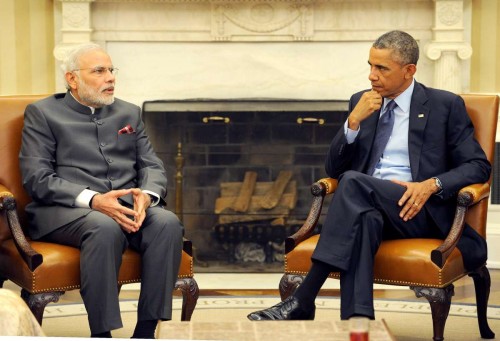
By Arun Kumar
Besides its powerful symbolism and optics, President Barack Obama’s presence as the guest of honour at India’s Republic Day reflects the big change in India-US relations since Prime Minister Narendra Modi came to power. He even advanced the State of the Union address to a joint session of the US Congress traditionally given in the last week of January, by a week to be at India’s day of pride and pageantry.
That tells what he thinks of India and how worthwhile it’s to spend his time and energy on a reenergised India that is more important and more influential and more of an opportunity, diplomatic sources told IANS.
The Obama visit starting Sunday marks many firsts – first American leader to stand in the open for over two hours to watch the parade despite the security challenge, first to make an India only trip for the second time while in office.
Today India enjoys a much higher credibility than on Sep 30 when Modi came calling to Washington for his first summit meeting with Obama just four months after a landslide historic win in Indian elections, they said.
Noting that every part of the joint statement issued after the September summit had been acted upon, the sources said India with its new get things moving style of working is today looked upon as an easier place to do business, travel and work with.
The idea of inviting the American leader in a “very political gesture” came from Modi, who is probably the first Prime Minister since Jawaharlal Nehru who sees foreign policy as a powerful tool to accelerate development.
Obama is expected to accompanied by First Lady Michelle Obama, but their daughters Malia and Sasha are likely to give the India trip a miss because of their school.
The Obama-Modi summit is expected to give them an opportunity to assess how much progress has been made since they met in Washington last September.
Besides a tour of the state of the world, the talks are expected to cover a lot of ground on economic issues as also, climate change, defence and security, including intelligence sharing and the stalled India-US nuclear deal.
US Undersecretary of defence Frank Kendall, the Pentagon’s point person for the bilateral defence relationship, is making his fourth trip to India to give a push to their Defence Trade and Technology Initiative (DTTI), ahead of Obama’s visit.
As part of DTTI, co-production and co-development of two critical defence systems — drones, and equipment for the C-130 transport military aircraft built by Lockheed Martin – are reported to be on the table.
A Contact Group set up by Modi and Obama at their September summit on advancing the implementation of civil nuclear deal has already held a couple of rounds to untangle the thorny issue of India’s tough liability law.
Obama and Modi are also likely to discuss the US troop withdrawal in Afghanistan and its implications for India’s security, tensions on India-Pakistan borders and cross-border terrorism.